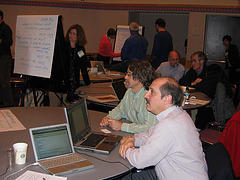"You're Richard Anderson, aren't you?" asked a fellow I didn't recognize at the farmers' market in San Francisco. "I attended alot of the BayCHI programs you ran for many years, and I'd just like to thank you so much for all the work you did. Those programs were really great and had a great impact on me and my thinking and my work."
Though I resigned my position as BayCHI Program Chair two and a half years ago, this type of interaction still occurs quite often, most recently at an eBay party in Portland, Oregon (site of CHI 2005) two weeks ago.
Sometimes the people who approach me in this way, as was true most recently at an Adaptive Path party last month, tell me that they took my full-semester user-centered design course and thought I was a great teacher, and say they are still using lots of what I taught. This is particularly interesting to me, since I last offered the course in the year 2000; hence, these people took my course no less than 5 years ago but sometimes as many as 12 years ago.
That Adaptive Path party -- a delightful throwback to parties of the dot.com boom days -- brought me face-to-face with several people who took my course. Not surprisingly, Peter Merholz, one of the principals of Adaptive Path, was there, who has said my course had a major impact on his career path. Lillian Svec was there; Lillian was the first Director of IA at Studio Archetype and Sapient, and later became Director, User Experience at Wallmart.com. Also there was Rick Bond, who became Manager of Intuit's User Experience group; Alex Wright, who was Director, User Experience at Phoenix-Pop; ...
I saw several former students of mine at the CHI conference as well. For example, Kit Lofgren was there; Kit is still head of Abbott Usability, which is doing some very interesting work, as she described to me during the conference reception. Pradeep Henry was there; Pradeep became very successful in India, where he founded and heads Cognizant's busy and growing India-based usability group, wrote a book on technical communication usability, founded South India CHI, developed the first usability conference series in India, etc. And so on.
I also ran into people who have worked for me in the past. For example, I was delighted to run into Michael Kronthal, whom I hired at Yahoo! and who proceeded to do nothing short of fabulous work there. Via those who have worked for me in companies such as Yahoo! and Sapient, I've been able to have a major impact on the roles user experience and user experience personnel play in those companies, which has been most rewarding to me.
"Look at all the people you've influenced," my girlfriend tells me alot, such as after the scene at the San Francisco farmers' market.
It has been a great pleasure, but there is much more influencing to be done. The DUX conference, UXnet, and the CHI 2005 Development Consortium provide venues via which I'm able to do some of this. But I'm eager to greatly extend the kind of work I've done when working within companies.

